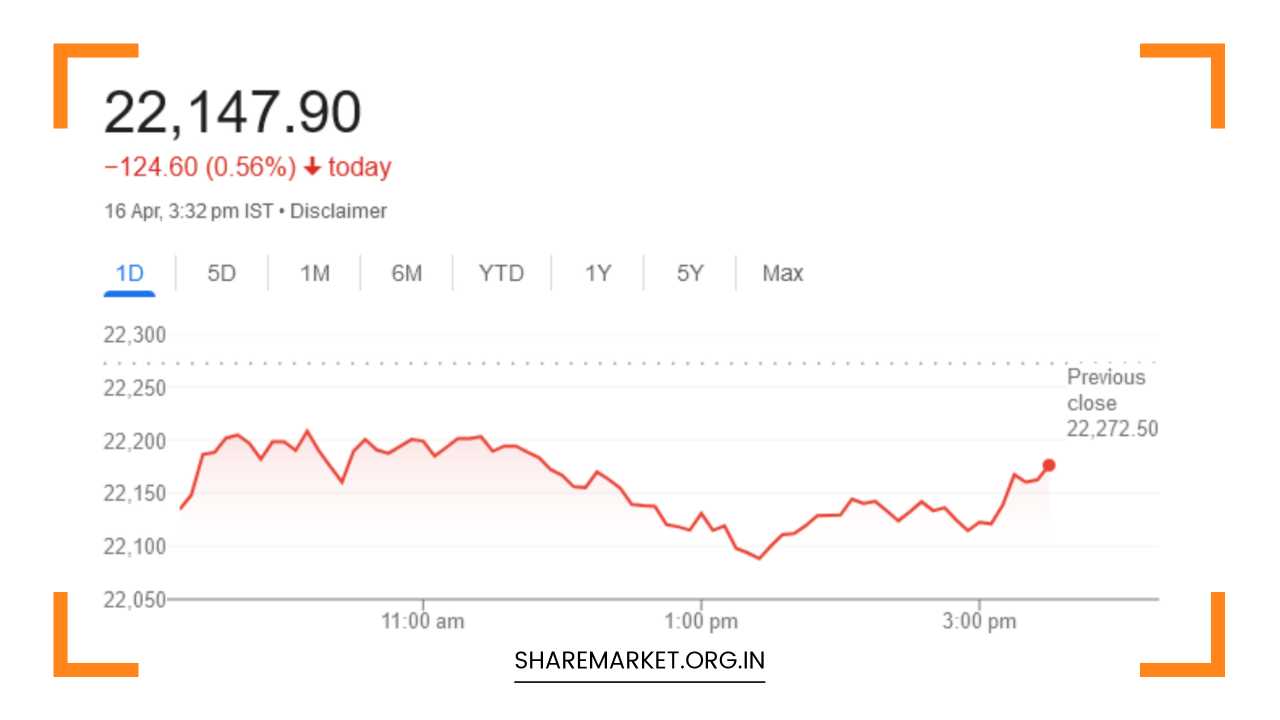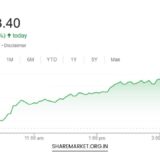Nifty Closed at 22,148; Nifty Prediction for Tomorrow

Nifty Prediction for Tomorrow
Stock Market Analysis: A Deeper Dive
Market Recap (April 16th)
Indian equity markets continued their downward trajectory for the second consecutive day, mirroring weak global cues. The benchmark indices, Sensex and Nifty, closed down by approximately 0.5%, settling at 72,944 and 22,148 points respectively.
This decline comes amidst growing concerns about rising inflation, tightening monetary policies, and geopolitical tensions.
Sectoral Performance & Underlying Factors
The decline was broad-based, with specific sectors experiencing amplified losses. Here’s a breakdown of the key sectoral movements and potential contributing factors:
- Realty and Infrastructure: These sectors witnessed the steepest falls, likely due to concerns about rising interest rates impacting affordability and project financing. Additionally, a slowdown in economic growth can dampen demand for real estate and infrastructure projects.
- IT, Banking, and Metals: These sectors faced selling pressure, reflecting a cautious investor sentiment. Rising bond yields can make these sectors less attractive compared to fixed-income instruments. Furthermore, global economic uncertainties can dampen demand for IT services, metals, and loan growth in the banking sector.
Countercurrents & Areas of Strength
While the overall trend was negative, some sectors offered some respite. Here’s a closer look:
- Mid-Cap and Small-Cap Indices: The mid-cap index remained flat, while the small-cap index defied the trend and closed marginally higher. This divergence suggests that investor focus might be shifting towards smaller companies, potentially anticipating higher growth prospects or lower valuations compared to large-caps.
- PSE, Pharma, and FMCG: These sectors managed to end the day in positive territory. This could be attributed to their perceived stability and defensive nature during market downturns. Investors might be seeking refuge in these sectors as they offer relatively consistent dividends and earnings, regardless of economic cycles.
The Rupee’s Depreciation: Adding Fuel to the Fire
Adding to the market woes, the rupee continued its depreciation against the US dollar. It weakened by 9 paise and closed at a record low of 83.54.
This depreciation raises concerns about potential capital outflows from foreign investors, who might find Indian assets less attractive due to currency fluctuations.
Additionally, a weaker rupee can lead to imported inflation, further pressuring the markets.
Analyst Views on Market Direction (April 18th)
With the market closed tomorrow (April 17th) for the Ram Navami holiday, investors are eagerly anticipating the direction it might take on April 18th. Here’s a breakdown of expert opinions incorporating both technical and fundamental analysis:
-
Technical Analysis: Technical analysts focus on historical price movements and chart patterns to predict future trends.
- Rupak Dey (LKP Securities): Dey predicts a potential rise for Nifty towards 22,400, with strong support at 21,930. However, he acknowledges a technical trend weakening due to the index falling below its 21-day exponential moving average (EMA). A crucial support zone lies in the 21,930-22,030 band. If this support breaks, panic selling might intensify. On the upside, resistance is expected at the 22,400 level.
- Kunal Shah (LKP Securities): Shah warns of further selling pressure if Bank Nifty breaches the 47,300 mark. The index witnessed a volatile session but managed to close above its 20-day moving average (DMA) at 47,500. Maintaining this level could lead to a pullback towards 48,000. However, a closing below 47,300 might trigger a decline to 46,500.
-
Fundamental Analysis: Fundamental analysts focus on factors like company performance, economic data, and global events to assess the intrinsic value of a company or market.
- ICICI Securities: Analysts at ICICI Securities anticipate a potential extension of the current decline towards the next major support at 21,900, which coincides with a retracement level from the previous month’s rally. This could be followed by a consolidation phase as the earnings season picks up. On the flip side, any uptrend would face resistance at 22,800.
- VK Vijayakumar (Geojit Financial Services): Vijayakumar highlights the rising bond yields, which could deter the US Federal Reserve from implementing rate cuts this year. This could dampen global investor sentiment and impact Indian markets. Additionally, he mentions the ongoing Israel-Iran conflict, which can further escalate geopolitical tensions and disrupt global supply chains.
Investor Takeaway: Navigating Uncertainty
The overall message from analysts is one of caution. The market is likely to remain volatile in the near
term, influenced by a complex interplay of global and domestic factors. Here are some key points for investors to consider as they navigate this uncertain market environment:
Global Cues:
- US Federal Reserve Policy: Monitor the US Federal Reserve’s stance on interest rates. Rising interest rates can potentially lead to capital outflows from emerging markets like India.
- Geopolitical Tensions: Stay informed about developments in the Israel-Iran conflict and other global hotspots. These conflicts can disrupt trade flows and impact investor risk appetite.
- Commodity Prices: Keep an eye on global commodity prices, especially oil. Rising oil prices can fuel inflation and put pressure on the Indian economy.
Domestic Factors:
- Earnings Season: Pay close attention to upcoming company earnings reports. Strong earnings reports from key companies can boost investor confidence and trigger rallies in specific sectors.
- Macroeconomic Data: Monitor key economic data releases like inflation numbers, GDP growth figures, and industrial production data. These data points provide insights into the health of the Indian economy and can influence market sentiment.
- Government Policies: Be aware of any upcoming government policies or reforms that could impact specific sectors or the broader economy.
Investment Strategies:
- Diversification: Maintain a well-diversified portfolio across sectors and asset classes. This can help mitigate risk and protect your investments from market downturns.
- Risk Management: Employ effective risk management strategies like stop-loss orders to limit potential losses.
- Long-Term Perspective: Maintain a long-term perspective on your investments. While short-term volatility is inevitable, the Indian market has a history of recovering from downturns.
- Consult a Financial Advisor: Consider seeking guidance from a qualified financial advisor who can help you develop a personalized investment strategy tailored to your risk tolerance and financial goals.
By staying informed, practicing sound investment principles, and adapting your strategy to changing market conditions, investors can increase their chances of success in navigating this volatile market environment.
Remember, the stock market is a dynamic system, and expert predictions are not guarantees of future performance.
However, by understanding the various factors at play, investors can make informed decisions and position themselves for potential opportunities that may arise amidst the current market turbulence.

















